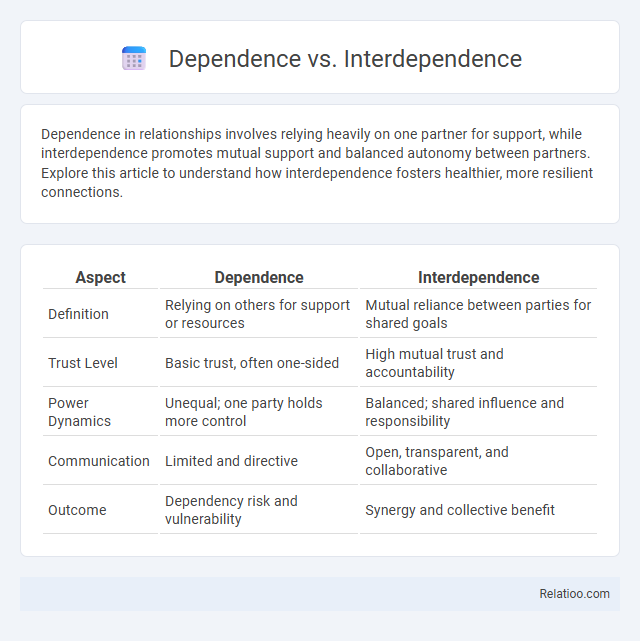Dependence in relationships involves relying heavily on one partner for support, while interdependence promotes mutual support and balanced autonomy between partners. Explore this article to understand how interdependence fosters healthier, more resilient connections.
Table of Comparison
| Aspect | Dependence | Interdependence |
|---|---|---|
| Definition | Relying on others for support or resources | Mutual reliance between parties for shared goals |
| Trust Level | Basic trust, often one-sided | High mutual trust and accountability |
| Power Dynamics | Unequal; one party holds more control | Balanced; shared influence and responsibility |
| Communication | Limited and directive | Open, transparent, and collaborative |
| Outcome | Dependency risk and vulnerability | Synergy and collective benefit |
Understanding Dependence: Definition and Characteristics
Dependence refers to a state where one entity relies heavily on another for support, resources, or functionality, often resulting in vulnerability and limited autonomy. Key characteristics include an imbalance of power, reduced self-sufficiency, and a reliance that may inhibit growth or independence. Understanding dependence involves recognizing these dynamics and the potential impacts on individual or organizational resilience.
Interdependence Explained: Key Concepts
Interdependence involves mutual reliance between individuals or systems, fostering collaboration and shared benefits. Unlike dependence, which implies one-sided reliance, interdependence emphasizes balanced, reciprocal relationships that enhance resilience and adaptability. Key concepts include trust, communication, and coordinated effort, essential for effective teamwork and sustainable partnerships.
The Psychological Impacts of Dependence
Dependence often leads to reduced self-esteem and increased anxiety due to reliance on others for emotional support or decision-making. Interdependence fosters healthier psychological well-being by promoting mutual support and balanced autonomy, enhancing resilience and trust. Excessive dependence can result in feelings of helplessness and vulnerability, increasing the risk of depression and emotional instability.
Benefits of Cultivating Interdependence
Cultivating interdependence fosters collaboration and shared responsibility, leading to increased innovation and resilience within teams and communities. This balanced relationship combines the strength of individual autonomy with mutual support, enhancing problem-solving and resource sharing. Unlike dependence, which creates reliance on others, or independence, which may lead to isolation, interdependence promotes sustainable growth through interconnected efforts.
Dependence vs Interdependence: Core Differences
Dependence involves relying on others for support or resources, often resulting in a one-sided relationship where one party lacks autonomy. Interdependence signifies a mutual reliance where both parties contribute and benefit equally, fostering collaboration and shared responsibility. Understanding these core differences helps You build balanced connections that promote growth and resilience rather than dependency.
Signs You Are Dependent or Interdependent
Signs you are dependent include relying heavily on others for decision-making, seeking constant approval, and feeling anxious when alone. Indicators of interdependence involve mutual support, shared responsibility, and effective communication where both parties contribute equally. Recognizing these patterns helps foster healthier relationships by balancing autonomy with collaboration.
Effects on Relationships: From Dependency to Mutual Support
Dependence often creates imbalanced relationships where one party relies excessively on the other, leading to potential strain or resentment. Interdependence fosters mutual support, enhancing trust and cooperation by valuing each partner's contributions equally. Shifting from dependence to interdependence strengthens relational resilience and promotes emotional growth through shared responsibility and collaboration.
Building Interdependence: Practical Strategies
Building interdependence involves shifting from individual dependence to a collaborative mindset where mutual goals and shared responsibilities thrive. Your team can implement practical strategies such as fostering open communication, encouraging trust-building activities, and aligning individual strengths with group objectives to enhance interconnectedness. This approach not only improves productivity but also strengthens relationships, creating a resilient, high-performing work culture.
Overcoming Unhealthy Dependence Patterns
Overcoming unhealthy dependence patterns requires recognizing the differences between dependence, interdependence, and codependence. Dependence involves relying heavily on others for emotional or practical support, often leading to vulnerability, while interdependence fosters mutual support and personal growth through balanced relationships. You can strengthen your emotional resilience by cultivating interdependence, promoting autonomy without sacrificing connection or support.
Dependence and Interdependence in Workplace Dynamics
Dependence in workplace dynamics occurs when employees rely heavily on supervisors or specific colleagues for guidance and decision-making, potentially limiting autonomy and innovation. Interdependence, however, fosters a collaborative environment where team members mutually rely on each other's skills and expertise, enhancing productivity and problem-solving capacity. Organizations that promote interdependence tend to experience improved communication, increased trust, and stronger overall performance.

Infographic: Dependence vs Interdependence
 relatioo.com
relatioo.com